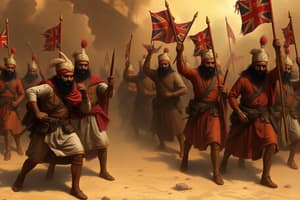Podcast
Questions and Answers
What was the main purpose of the British East India Company?
What was the main purpose of the British East India Company?
- To convert Indians to Christianity
- To colonize the entire continent
- To trade goods globally (correct)
- To establish a military presence in India
Which natural resource mentioned was used to make ropes?
Which natural resource mentioned was used to make ropes?
- Indigo
- Spices
- Gold
- Jute (correct)
What is indigo primarily used for?
What is indigo primarily used for?
- Creating dyes for fabrics (correct)
- Making ropes
- Harvesting spices
- Producing oils
Why was the geographical location of India significant for trade?
Why was the geographical location of India significant for trade?
How did the British East India Company utilize India's large population?
How did the British East India Company utilize India's large population?
What was a common practice regarding tea before it was shipped to England?
What was a common practice regarding tea before it was shipped to England?
Which of the following products was NOT explicitly mentioned as a resource extracted from India?
Which of the following products was NOT explicitly mentioned as a resource extracted from India?
What role did the British East India Company have in processing raw materials?
What role did the British East India Company have in processing raw materials?
What law did the British East India Company create regarding cloth production in India?
What law did the British East India Company create regarding cloth production in India?
What was the primary cause of the conflict between British officers and Indian soldiers during the Sepoy rebellion?
What was the primary cause of the conflict between British officers and Indian soldiers during the Sepoy rebellion?
What term is used to refer to Indian soldiers working under British officers?
What term is used to refer to Indian soldiers working under British officers?
What was the outcome of the Sepoy rebellion for the British East India Company?
What was the outcome of the Sepoy rebellion for the British East India Company?
How did the British officers respond to the Indian soldiers' concerns regarding the new rifle's cartridge?
How did the British officers respond to the Indian soldiers' concerns regarding the new rifle's cartridge?
How did the British East India Company's military capabilities compare to other entities?
How did the British East India Company's military capabilities compare to other entities?
Which two religious groups formed the majority of the population that was affected during the conflict?
Which two religious groups formed the majority of the population that was affected during the conflict?
What was the name of the rifle that caused significant issues during the conflict?
What was the name of the rifle that caused significant issues during the conflict?
Flashcards are hidden until you start studying
Study Notes
The British East India Company
- The British East India Company was a joint-stock company that traded goods globally.
- In India, the Company focused on extracting natural resources like spices, gold, jute (for rope), and indigo (for dye).
- The Company processed some materials in India and shipped others back to Britain for processing.
- India's strategic location and large population were key factors for the Company's operations.
- The Company had its own army which included Indian soldiers (Sepoys).
- The Company's monopoly on cloth production forced Indians to buy British goods.
Sepoy Rebellion
- The Sepoy Rebellion was a conflict between British officers and Indian soldiers over the use of a new rifle with cartridges greased with animal fat.
- This practice was offensive to both Hindu and Muslim Sepoys, as it violated their religious beliefs.
- The British ignored the Sepoys' concerns, leading to the rebellion.
- The British ultimately won the rebellion but were held accountable by the British Parliament.
- The rebellion marked a turning point in British rule in India as the British government began considering alternative governing strategies.
Studying That Suits You
Use AI to generate personalized quizzes and flashcards to suit your learning preferences.




